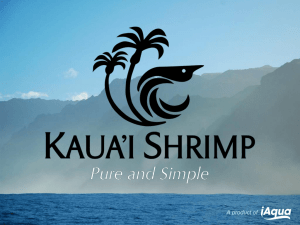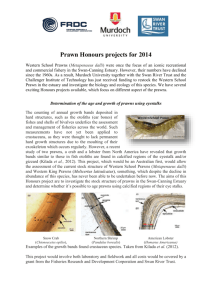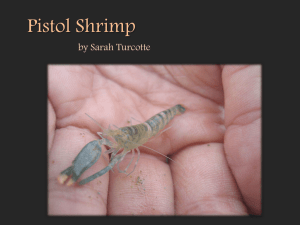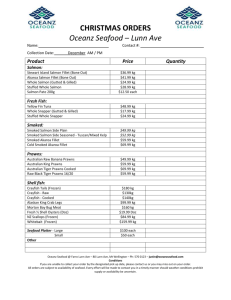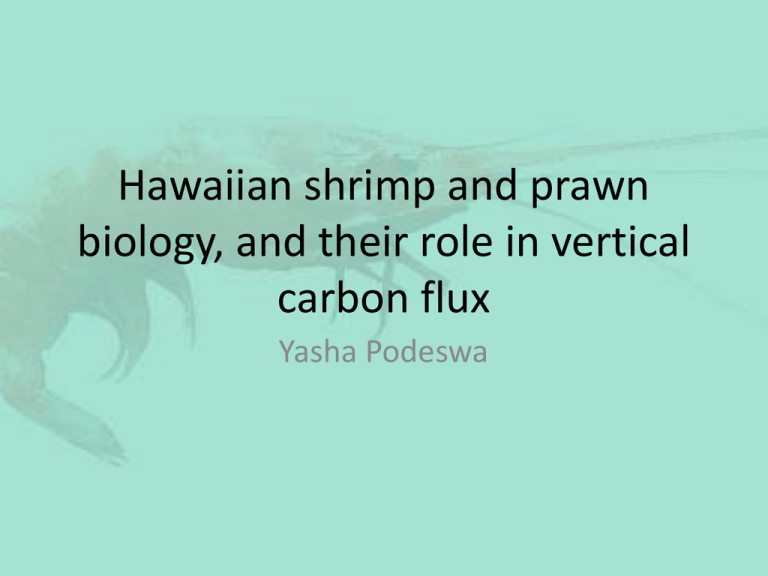
Hawaiian shrimp and prawn
biology, and their role in vertical
carbon flux
Yasha Podeswa
What are shrimp and prawns?
• Both crustaceans from the Order
Decapoda
• Shrimp:
– Suborder Pleocyemata, Infraorder
Caridea
• Prawns:
– Suborder Dendrobranchiata
Why study pelagic Hawaiian shrimp
and prawns?
• Biology of most local shrimp and prawn species
undescribed
– Morphometrics (size/shape), sex ratios, fecundity
(reproductive rate of an organism/population),
diet/position in food web
• Little commercial harvest, but may be harvested in the
future
– Pre-harvest data important but often unavailable
– Understand the “baseline”
• Locally very abundant, could play a large role in vertical
carbon flux through active vertical migrations
Goals of my study
• Describe the biology of all
pelagic shrimp and prawns in
the open ocean near Hawaii,
including surface, mesopelagic,
and migratory populations
• Estimate the contribution of
migratory shrimp and prawns to
vertical carbon flux
Why has nobody studied this before?
• Fish generally well studied
• Zooplankton generally well
studied
• Micronekton generally not
well studied
– Small but bigger than
plankton, free swimmers
– Avoid plankton nets, too
small to be caught by most
fishing nets
Methods
• Used 3 different sampling gears
with different mesh sizes
30
45
Depth (m)
• 58 casts, sampled at day and night,
sampling both surface scattering
layer (roughly top 100 m) and deep
scattering layer (roughly top 500 m)
15
60
HUFT
IKMT
Cobb Trawl
75
90
105
120
135
150
Daytime horizontal tows (1hr at depth)
0
150
Depth (m)
– Cobb trawl (10 mm)
– Isaacs-Kidd Midwater Trawl (5 mm)
– Hokkaido University Frame Trawl (3
mm)
Nightime oblique tows (1hr)
0
300
450
600
750
HUFT
IKMT
Cobb Trawl
Methods
• Classify all shrimp and prawns in
the samples
– Many samples over 50% shrimp
and prawns by volume
– 32 species identified from 8
families
• Measure carapace length, total
length, wet weight and dry weight
• Sex individuals based on appendix
masculina (for shrimp) and petasma
(for prawns)
• Determine fecundity through
counting eggs and oocites at
various stages of development
• Determine diet/food web location
through gut content analysis and
stable isotope analysis
Stable isotope analysis
• Gut content analysis
– Underestimates easily digested prey
– Often very difficult to identify prey to species level
– Only contains very recent meals
– Hard to get quantitative data
• Stable isotope analysis
– Quantitative data
– No bias towards hard to digest prey
– Integrates diet over a longer timescale
Stable isotope analysis
• “You are what you eat”
– Predator should have similar isotopic makeup of
prey
• Measure the amount of heavy isotopes of
carbon (13C) and nitrogen (15N) in muscle
tissue, calculate the ratio of the heavy isotope
to the lighter, more common isotope
d13C=
13C 12C
(C
13
sample
12C
standard
)
1
1000
Stable isotope analysis
• d13C and d15N measured
through mass
spectrometry
• The predator’s d15N
signature will generally
be about 3.2 ‰ greater
than its prey’s
• The predator’s d13C
signature will be very
similar to the prey’s,
only about 1 ‰ greater
Stable isotope analysis
• Why the enrichment?
– Lighter isotopes (12C and 14N) are preferentially
metabolised
– Heavier isotopes (13C and 15N) are retained, and are
thus enriched in the predator’s tissues
– Small enrichments from prey to predator in d13C allow
the source of primary production to be easily
identified
– Larger enrichments from prey to predator in d15N
allow trophic levels to be distinguished more
accurately
Stable isotope analysis
• Simple food chains can
be identified visually
• Complex food webs
can be estimated using
mixing models
Vertical carbon flux
• The oceans have absorbed about 48% of total
fossil fuel and cement manufacturing CO2
emissions since the beginning of the industrial
revolution
• The ocean’s carbon reservoir dwarf’s the carbon
reservoir in the atmosphere
–
–
–
–
Over 1,000 Gt C in surface waters
Roughly 38,000 Gt C in mid and deep waters
Roughly 78,000,000 Gt C in ocean sediments
Roughly 600 Gt C in the pre-industrail atmosphere
Vertical carbon flux
• The ocean is density stratified
– Not well mixed outside of the surface layer (upper few
meters to upper few hundred meters)
• Mixed layer shallow in the tropics, simple turbulence
not responsible for much vertical carbon flux
• Carbon is sequestered in the ocean primarily through
the “solubility pump” and the “biological pump”
Vertical carbon flux
• Solubility pump
– CO2 more soluble in cold water than warm water
– More dissolved CO2 in cold, high latitude waters than warm, low
latitude waters
– Deep water forms at high latitudes, thus pumping high CO2 water from
the surface to the deep ocean
• Not very significant in the tropics, not a down welling region
Vertical carbon flux
• Biological pump
– CO2 fixed into organic C
through photosynthesis
– Sinks as “marine snow,”
aggregates of dead or
dying phytoplankton,
dead or dying
zooplankton, faeces
and mucus
– The carcases of larger
animals (such as whale
carcasses) can also
contribute to vertical
carbon flux
– Active vertical
migration can also be
important
Vertical migration
• Virtually all
zooplankton and
micronekton in the
oceans perform diel
vertical migrations
– Spend the night at
the surface, and the
day at depth
– Some also perform
seasonal vertical
migrations
Vertical migration
• Driving force behind vertical migrations still
somewhat debated, but generally seen to be
based on the following factors:
– Surface food quality and quantity
– Visual predator avoidance
– Metabolic gains
– Avoidance of UV damage
Active carbon transport
• Some carbon is transported
downwards through formation of
faeces at depth
– Short gut clearance times for many
zooplankton make this of minimal
significance, but for larger shrimp
and prawns it could be more
significant
• Much carbon is also transported
through respiration of CO2 and
excretion of DOC
Active carbon transport
• Previous studies tend to
focus on smaller migrators,
especially krill
– Generally make up the bulk
of migratory biomass, but
pelagic shrimp and prawns
much more abundant in this
ecosystem
– Krill are generally shallow
migrators (top 100 m),
shrimp and prawns migrate
much deeper, could
contribute much more to
vertical carbon flux if present
in similar biomass
Active carbon transport
• Previous studies focusing on krill and other
zooplankton migrators in the upper 100 m have
shown them to contribute significantly to vertical
carbon flux, ranging from 6 – 34% of POC flux
• Fluxes due to the less abundant micronekton
have generally been ignored, but may be very
locally significant in this ecosystem due to high
relative biomass, deeper migrations, and longer
gut clearance times
Active carbon transport
• My preliminary findings show that many
Hawaiian shrimp and prawns migrate to deep
depths (to around 500 m), and only a fraction
of the population migrates to the surface each
night
– Thus spend numerous days/hours at depth for
every day/hour at the surface, facilitating carbon
transport
Wrapping up . . .
• Understanding the role of pelagic shrimp and
prawns in the ecosystem through studying their
biology, diet, and their contribution to vertical
carbon flux should aid in any management
decisions in the future, especially should this
become a commercial fishery



